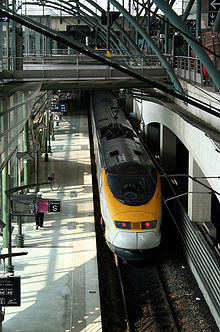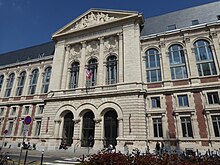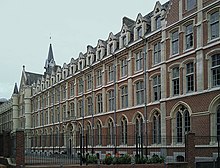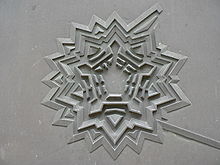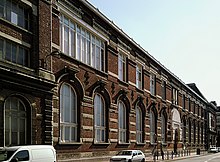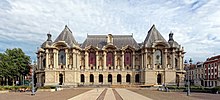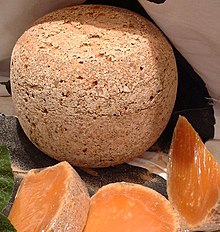Lille
Lila or Lille ![]() [lil] (?·i) is a city in the north of France, capital of the region of Alta France, and located very close to the border with Belgium, which is located on the banks of the river Deûle, a tributary of the river Lys.
[lil] (?·i) is a city in the north of France, capital of the region of Alta France, and located very close to the border with Belgium, which is located on the banks of the river Deûle, a tributary of the river Lys.
According to 2019 data, Lille has a municipal population of 236,400 inhabitants, and its metropolitan area, which includes cities such as Villeneuve-d'Ascq, Roubaix and Tourcoing, has a population of 1,164,716 inhabitants, being the fourth largest in France.
Situated between Paris, London and Brussels, Lille is a European economic center, which has developed considerably since the 1990s, especially with the construction of the Euralille business district and the arrival of High Speed Trains and Eurostars. With 110,000 students, Lille is also the third largest university city in France, after Paris and Lyon. It was also the European Capital of Culture in 2004 and since then, it is qualified as "Ville d'art et d'histoire" (City of art and history).
Etymology
The current city of Lille developed from the agglutination of various population centers located at the end of the navigable part of the banks of the Deûle river. The name of the city comes from the denomination L'île (in Spanish, La Isla), which refers to the location of the city on a surface of land firm surrounded by old fluvial swampy areas, which gave the appearance of the city being located on an island between marshes. The city's important textile industry gave rise to the name lile (Lille in Spanish), a name for a colored woolen fabric of Scottish origin, typical of local industrial production..
History
Old Age
The first remains found in present-day Lille date from around 2000 BC. C., when, after the invention of agriculture, some settlers settled on the banks of the Deûle River and built farms and farms. The excavations carried out in areas close to the river have made it possible to find remains of those settlements, dating from the Bronze and Iron Ages, and corresponding to the Celtic peoples who occupied the entire European Atlantic coast.
After the Roman conquest of Gaul, the settlements on the Deûle River grew, although what we know today as Lille was no more than a scattered group of population centers linked by secondary roads. With the Romanization process, the inhabitants of the area adopted the Gallo-Roman culture. At the end of the century V a. C., a nucleus located on the eastern bank of the river began to grow slowly, being the densest of all the surrounding populations. In the future, this location would become the germ of the future city.
Middle Ages
After the fall of the Roman Empire, the location of the eastern bank of the Deûle gradually brought together the inhabited areas around it. The origin of the city of Lille is narrated by the medieval legend of "Lydéric and Phinaert". This legend tells that Lydéric was the son of Salvaert and Ermengaert, princes of Dijon. When they were going to England to father their future son, they were arrested by Phinaert, giant and lord of the lands of present-day Lille, who also executed Salvaert. Ermengaert was able to flee and, before passing away, she gave birth to Lydéric, who had to grow up with a hermit, fleeing from the giant. When Lydéric grew up, he murdered Phinaert in revenge for the death of his parents, and received the giant's lands, where he founded in 640 the city of L'Ile, from which according to legend it derives the name of Lille.
Throughout the Middle Ages, present-day Lille was part of the County of Flanders, a vassal territory of the Frankish kingdom, which brought together the ancient Roman cities of Arras, Cambrai and Boulogne; and even became its capital. Due to its strategic location, at the end of the navigable part of Deûle, the nucleus of L'Isle gradually gained commercial importance, with the construction of a river port. From 830 to 910, the Vikings plundered the cities of the Flanders region, including L'Isle. For this reason, the counts of Flanders, rulers of the city, undertook to fortify the city. The first document that mentions the current name of Lille dates from the year 1066, in which the parish of Saint-Maurice, the oldest church in the town, is also mentioned. Already from the Early Middle Ages, Lille stood out for its long tradition of textile crafts. With the establishment of the court of the counts of Flanders, the city acquired greater economic importance and experienced greater demographic growth. In 1144 the parish of Saint-Sauveur (San Salvador) would be constituted, which would be the origin of the future cathedral of the city.
Although the region was dependent on the kingdom of France, the county of Flanders maintained, for economic reasons, very close ties with England and the Holy Roman Empire. For this reason, and in order to maintain hegemony in Flanders, the French King Felipe II Augusto intended to occupy the region. Due to French interests, the King of England John the Landless, the German Emperor Otto IV and Ferdinand of Portugal, Count of Flanders, formed a coalition against France. Philip II Augustus besieged and occupied Lille in 1213, and the conflict ended in 1214 with the French victory at the Battle of Bouvines. The result of the war allowed to maintain the county of Flanders, again under French hegemony. During the 13th century, Lille reached the 30,000 inhabitants, and its economic importance increased thanks to the celebration of a regional market, and above all because of the thriving local cloth industry, which attracted foreign merchants from all over Europe. This situation made the city a coveted center for both France and England, who fought over Lille during the Hundred Years' War.
Starting at the end of the 14th century (1369), and in the context of the Hundred Years' War, the city was governed by the Dukes of Burgundy, who proclaimed themselves Counts of Flanders by the marriage between Duke Felipe II the Bold and Countess Marguerite de Mâle. Under Burgundian rule, and during the duchy of Felipe III the Good himself, the reconstruction and repopulation of the city was undertaken, which had suffered severe damage caused by wars and plague epidemics. Among other works, the Burgundian duke ordered the construction of the Rihour palace, the city's new court. Maria de Borgoña, granddaughter of Philip III the Good and sole successor to the duchy, married Maximilian I, future Holy Roman Emperor. Due to this union, the city of Lille and the county of Flanders as a whole passed into the hands of the Habsburgs, within the lordship of the Netherlands. The result of this union was born in 1478 Felipe I de Habsbugo, better known as El Hermoso, who would reign in the city between 1482 and 1506. During this period, of relative calm, Lille began to develop an industry of light fabrics, to the detriment of cloth production.
Modern Age
By decision of his father Maximilian I, Felipe married Juana I of Castile, daughter of the Catholic Monarchs. With this succession of marriage links, Lille and the rest of the county of Flanders, as well as the territories of Burgundy and Brabant, would finally pass into the hands of the Habsburg family. Thus, Carlos de Habsburgo ( Carlos I of Spain ) counted it among his domains, asserting to the monarch his title of Lord of the Netherlands. The city was ruled by the Habsburgs until the reign of Philip IV, in the first half of the 17th century. During the 16th and 17th centuries, the city lived through troubled periods, being devastated on various occasions by plague epidemics and religious wars between Catholics and Protestants, although it was able to maintain its textile and commercial wealth. The heritage of the reign of the House of Habsburg in the city is the building of the Old Stock Exchange, in 1652, which reflects the economic splendor that the city lived at that time; in addition to other civil buildings, of evident Flemish Renaissance style.
In the early second half of the 17th century, the French King Louis XIV initiated an expansionist policy towards the north and eastern France. Luis XIV claimed the territory of Flanders, in Spanish hands, asserting the succession rights of his wife María Teresa of Austria, daughter of Felipe IV of Spain. With these claims, the Return War would begin in 1667, which would end with the French occupation of the County of Flanders. The French king besieged and took the city of Lille on August 28, which was occupied after seventeen days of resistance. Now united in the French kingdom, Lille would become the capital of northern France.
Because of its strategic location, very close to the border with the Spanish Netherlands, and its economic importance, Louis XIV ordered it to be fortified, four months after having conquered it. The task was entrusted to Sébastien Le Prestre, Marquis de Vauban, engineer and military architect. Vauban reinforced the city walls and directed the construction of the citadel of Lille, in the north-western corner of the city.
Under French rule, the city experienced a century of economic stability, although it was occupied by the Dutch army between 1708 and 1713, within the context of the War of Spanish Succession.
Contemporary Age
Lille under the French Revolution
At the end of the XVIII century, the local industry, basically based on the production of textiles, began to diversify, introducing lace, ceramics and food manufactures, since Lille's textile industry, which could not compete with the thriving and mechanized English manufacturing, experienced a period of economic crisis. After the French Revolution, in 1789, the local bourgeoisie would dominate the city, without any major riots taking place in Lille. Faced with the foreign threat to overthrow the revolution, the French National Assembly declared war on Austria, an absolutist power, in 1792. With the Netherlands in Austrian hands during that period, Lille found itself on the front line between France and Austria, under constant bombardment. From his resistance against the Austrians arose the expression that "Lille has a well-deserved homeland".
Industrial Revolution
During the first half of the 19th century, Lille's textile industry took off again, after suffering a revolutionary hiatus. The city would specialize mainly in the production of cotton and linen fabrics. Lille became the largest industrial center in France, and its garment manufacturing became one of the largest in the world. The metallurgical industry was also developed, thanks to the discovery of large coal deposits near the area; and the railway industry. In 1846 the railway arrived in the city, with the Paris-Lille link, and soon after it became a railway junction of notable importance. The industrial revolution skyrocketed the population of Lille, from 75,000 inhabitants in 1850, to have 220,000 in 1901. This fact led to increased pollution and unsanitary conditions in the city, so that nineteenth-century sanitation and urbanization projects were carried out. In 1896 the University of Lille would be created, and in this period the city began to experience the commercial development of the city.
In this context of industrialization, wide contrasts emerge between the local bourgeois business community and the working population. Due to the industrial nature of the city and its good communication with Paris, the proletarian classes quickly embraced socialism. From the end of the XIX century the city council would be governed by socialist mayors.
Interwar Period
As a result of its location on the Franco-German front during World War I, Lille was severely hit by bombardments by the French and German armies. The city was quickly occupied by the Germans, until it was recaptured by the British army in the summer of 1918, after heavy trench warfare.
Starting in 1927, the city council of Lille undertook a plan to restructure the city, under the mayoralty of the socialist Roger Salengro. The plan included the demolition of the most disadvantaged neighborhoods, as well as the construction of the Lille International Fair, a river port and the Marcq-en-Baroeul airport.
During the 1930s, the city entered a severe economic crisis derived from the Crash of 1929. The local crisis worsened in 1936 with the suicide of the mayor himself, Roger Salengro, and with the outbreak of World War II. The Nazi troops, within the scene of the blitzkrieg, decided to besiege the city, surrounding it on May 27, 1940 and occupying it on June 1. During the German occupation, Lille, like the rest of Nord-Pas de Calais, was controlled from the German administration in Brussels. In September 1944, the allied troops liberated the city after successive bombardments.
Since 1945
Lille was once again destroyed by the damage caused in World War II. The city did not fully recover its industrial and commercial activity until five years after the world conflict. In 1951 the International Textile Fair was held, which marked the local economic resurgence. From the fifties, the city was expanding from the suburbs. In 1967 the Paris-Lille motorway was completed, in addition to establishing, at the request of the socialist mayor Auguste Laurent, the Lille-Roubaix-Tourcoing chamber of commerce, with the intention of creating one of the largest commercial and industrial centers in Europe. In 1977 the nearby town of Hellemmes would join this conurbation. It is in this period that the local industrial sector will enter into a definitive crisis, which will lead to the tertiarization of the city. This phenomenon will mean a profound change in the economic pulse of Lille. In 1983 Lille, Hellemmes and Villeneuve d'Ascq were connected with the VAL metro line (the first automatic metro line in the world). Today the four nuclei of the urban community (Lille, Roubaix, Tourcoing and Villeneuve d'Ascq) are connected to the VAL, the largest automatic network in the world that reaches as far as the Belgian border.
During the 1990s, Lille will assume a vital economic role in the new European community, with the rail connection to the TGV in 1993 and the inauguration of the Eurotunnel under the English Channel in 1994. Mayor Pierre Mauroy plans and builds a new financial and commercial district in the city, called Euralille, marking the restructuring of the city at the end of the XX century. From 2001 to the present, the socialist Martine Aubry governs the city. In 2004, the city was named the cultural capital of Europe. It should also be said that the city was a candidate to celebrate the 2004 Olympic Games, without actually achieving it.
Today, Lille forms one of the largest conurbations in France and continues to maintain its economic weight in the European Union. Its urban community is the most populous of the Lille-Kortrijk-Tournai Eurometropolis, of which it has been a part since its formation in 2008.
Administration and politics
| Period | Name |
|---|---|
| Since 2001 | Martine Aubry |
| 1973-2001 | Pierre Mauroy |
| 1955-1973 | Augustin Laurent |
| 1955 | Guy Debeyre (special delegation) |
| 1947-1955 | René Gaiffie |
| 1944-1947 | Denis Cordonnier |
| 1940-1944 | Paul Dehove |
| 1936-1940 | Charles Saint-Venant |
| 1929-1936 | Roger Salengro |
| 1929 | Alexandre Bracke‐Desrousseaux |
| 1925-1929 | Roger Salengro |
| 1919-1925 | Gustave Delory |
| 1904-1919 | Charles Delesalle |
| 1896-1904 | Gustave Delory |
| 1881-1896 | Géry Legrand |
| 1878-1881 | Jules Dutilleul |
| 1873-1878 | André Catel-Beghin |
| 1867-1873 | Charles Crespel-Tilloy |
| 1867 | Jules Meunier |
| 1866-1867 | Auguste Flamen |
| 1852-1866 | Auguste Richebé |
| 1848-1852 | Pierre Bonte-Pollet |
| 1834-1848 | Louis Bigo-Danel |
| 1832-1834 | Desiré Le Thierry |
| 1830-1832 | Jean-Baptiste Smet |
| 1830 | François Barrois-Virnot |
| 1816-1830 | Jean Demuyssaert |
| 1803-1816 | Louis de Brigode |
| 1800-1803 | Nicolas Gentil-Muiron |
| 1799-1800 | François Thery Falligan |
| 1797-1799 | Jean-Baptiste Drapiez |
| 1797 | Claude Artaud |
| 1796-1797 | Ignace Capron |
| 1795-1796 | François André |
| 1794-1795 | Desjardins |
| 1793 | Guillaume Lefebvre-Dhenin |
| 1792 | François André |
| 1790-1791 | Louis Vanhoenacker |
- European metropolis of Lille
Lille-Roubaix-Tourcoing is part of the eight metropolises created in 1964 in France. The urban community of Lille was created in 1967 by the French government. On December 22, 1967, Augustin Laurent, mayor of Lille, was elected president and took office on January 1, 1968. The urban community of Lille has 89 cities. Its surface has not changed since then, but the number of cities passed from 87 to 85. On 4 February 1970, the mayors of Annappes, Ascq and Flers announced their merger to constitute the new city of Villeneuve d'Ascq. In 1977, the cities of Lille and Hellemmes are associated while, in 2000, it is the city of Lomme that is associated with the city of Lille.
The realization of the light automatic metro VAL (1983) currently represents one of the main works of the establishment. More recently, the urban community has decided to build a Grand Stadium in Villeneuve-d'Ascq. The cross-border cooperation of Lille Métropole, specified in the Grootstad project ("Gran Ciudad") that unites the metropolis of the department of Nord with Belgian collectivities, walnuts and flamencas (intermunicipal) must evolve towards a Eurodistrict.
On 13 December 1996, the urban community of Lille (Communauté urbaine de Lille - CUDL, in French) changes its name and becomes Lille Metrópoli Urban Community (CUDL)Lille Métropole Communauté urbaine - LMCU, in French.
On January 1, 2015, according to the MAPTAM law of January 27, 2014, Lille Metrópoli Urban community becomes the European Metrópoli of Lille (Métropole européenne de Lille - MEL, in French) and so he really gets the status of metropolis. This allows you to receive numerous competences attributed to the cities and also competences of the department.
Plus its surface could increase. The New Territorial Organization of the Republic Bill provides for the removal of communities from municipalities with less than 15,000 inhabitants. The Weppes Community of Municipalities (5,636 inhabitants) could join the metropolis.- European Union Railway Agency
Climate
| Month | Ene. | Feb. | Mar. | Open up. | May. | Jun. | Jul. | Ago. | Sep. | Oct. | Nov. | Dec. | Annual |
|---|---|---|---|---|---|---|---|---|---|---|---|---|---|
| Temp. max. abs. (°C) | 15.2 | 19 | 24.8 | 27.9 | 31.7 | 34.8 | 41.5 | 37.1 | 35.1 | 27.8 | 20.3 | 15.9 | 41.5 |
| Average temperature (°C) | 6.0 | 6.9 | 10.6 | 14.1 | 17.9 | 20.6 | 23.3 | 23.3 | 19.7 | 15.2 | 9.9 | 6.4 | 14.5 |
| Average temperature (°C) | 3.6 | 4.1 | 7.1 | 9.7 | 13.4 | 16.2 | 18.6 | 18.4 | 15.4 | 11.6 | 7.1 | 4.2 | 10.8 |
| Temp. medium (°C) | 1.2 | 1.3 | 3.6 | 5.4 | 8.9 | 11.7 | 13.8 | 13.6 | 11.2 | 8.1 | 4.4 | 1.9 | 7.1 |
| Temp. min. abs. (°C) | -19.5 | -17.8 | -10.5 | -4.7 | -2.3 | 0.0 | 3.4 | 3.9 | 1.2 | -4.4 | -7.8 | -17.3 | -19.5 |
| Total precipitation (mm) | 60.5 | 47.4 | 58.3 | 50.7 | 64.0 | 64.6 | 68.5 | 62.8 | 61.6 | 66.2 | 70.1 | 67.8 | 742.5 |
| Precipitation days (≥ 1 mm) | 11.7 | 9.6 | 11.4 | 10.1 | 10.6 | 10.0 | 9.8 | 9.2 | 10.1 | 11.0 | 12.6 | 11.3 | 127.4 |
| Days of snowfall (≥ 1 mm) | 4.9 | 4.1 | 3.2 | 1.3 | 0.1 | 0.0 | 0.0 | 0.0 | 0.0 | 0.0 | 1.8 | 3.8 | 19.2 |
| Hours of sun | 65.5 | 70.7 | 121.1 | 172.2 | 193.9 | 206.0 | 211.3 | 199.5 | 151.9 | 114.4 | 61.4 | 49.6 | 1617.5 |
| Relative humidity (%) | 88 | 85 | 82 | 79 | 78 | 79 | 78 | 78 | 83 | 87 | 89 | 90 | 83 |
| Source No. 1: Meteo France | |||||||||||||
| Source No. 2: Infoclimat.fr (humidity, snowy days 1961–1990) | |||||||||||||
Demographics
Transportation
The Metro de Lille (in French: Meter of Lille) is the first metro in the world that used VAL technology. The term VAL is an acronym that currently means Ligero Automatic Vehicle, although at first it meant Villeneuve-d'Ascq - Lille. Certain students of Villeneuve-d'Ascq later popularized the expression Vite À Lille, Vite Au Lit (Quickly A Lille, Quickly A la Cama).
Fully automated, the Lille subway does not need a driver, and it is demarcated from numerous other metropolitan networks by its protected platforms: there is no risk of falling on the road thanks to a vain vitreo and automatic doors over the entire length of the platform. The doors do not open more than when the train stops, making the climb and the descent of the passengers as in an elevator.
The Lille subway, contrary to its Parisian counterpart, the Paris metro, is a subway of small gálibo. A subway train is made up of two cars, although most of the stations have been conditioned to accommodate four trains.
At first, each municipality had its own budget so that it can choose an architect and an artist for the creation of the stations in its municipality. This measure was taken at the time of the construction of line 2. But at the time of its prolongation, certain new stations have not benefited from works of art.Education
- Universities
In the 16th century, thanks to the boost given by the Spanish monarchy to education in France, several universities were created in Lille. The University of Lille-Douai, is a public university founded in 1562. Since 1971, the public university of Lille (Université Lille Nord de France) is divided into three campuses on the outskirts of Lille:
- Campus Lille I: (USTL - Sciences and Techniques), on the campus "La cité scientifique" (the scientific city).
- Campus Lille II: (Right, Health, Business Administration and Sports), is located in the south, south-east of the city of Lille.
- Campus Lille III: (History, Letras et Artes), whose campus is in Villeneuve-d'Ascq, the neighborhood of " Pont de bois".
Lille is also home to the prestigious Sciences Po Lille school, a training house for the high French political elite. Admission to Sciences Po Lille is done through a highly selective competition (between 5.00% and 7.00% of pass rates).
In the last part of the 19th century, specifically in 1875, the Catholic University of Lille (Letters and Natural Sciences, Law, Economics and Management, Sciences and Techniques, Medicine and Theology) was created.
In 2007, Lille was the third city in France in number of university students with more than 95,000 in its metropolitan area, behind only Paris and Lyon and about the same as Toulouse. In 2003, a student census revealed that there are more than 144,000 students in the city, where 98,000 are in university, 29,000 in professional training studies and 17,000 in institutes.
- Colleges of general engineers
- École centrale de Lille
- ENSAM (National School of Arts and Crafts)
- École spéciale de mécanique et d'électricité
- HEI (high engineering studies)
- ICAM (Catholic Institute of Arts)
- Polytech'Lille (Lille Polytechnic School, formerly called EUDILnt EUDIL)
- Institute of Polytechnic Studies of Lille.
- Colleges of specialized engineers
- ENIC (Télécom Lille 1)
- ENSAIT (National School of Arts and Textile Industries)
- ENSCL (Lille Chemistry School)
- École pour l'informatique et les nouvelles technologies
- ESJ (Lille Senior Journalism School)
- ESTIT (high school of industrial and textile techniques)
- ISA (University Institute of Agriculture)
- ISEN (University Institute of Electronics and Numericals)
- IST (University Institute of Technology)
- ENSAPL (National School of Architecture and Landscape of Lille)
- Trade schools
- L' ESPAS Tecobio (ESPAS Tecobio)
- Edhec Business School
- L'ESA (Lille Business School)
- SKEMA Business School
- IÉSEG School of Management
- Institut supérieur européen de gestion group
- Institut supérieur européen de formation par l'action
Culture
Urban planning and architecture
- Citadel of Vauban
The citadel of Lille was designed by the military engineer Sébastien Le Prestre, Marquis de Vauban, four months after the French occupation of the city in 1667, by order of King Louis XIV, with the aim of forming a defensive line (known in French as pré carré). The citadel was built, between 1667 and 1670, in the northwest of the city in an area of marshes of the Deûle river, approximately 1700 hectares. This situation was used to build a system of floods and water channels, which would form part of the defense of the site, by surrounding it. Due to the magnitude of the project, in which Vauban revealed his logical approaches to military defense, the lowering of labor and material costs, and the importance of artillery in the design of flush fortifications, the same architect defined his work as the "queen of citadels", and is in fact considered his masterpiece. Vauban, who had been appointed General Commissioner of Fortifications of the French army, and who had been in charge of reinforcing strategic positions on the French borders, proposed the construction of polygonal fortifications in the citadel, according to the needs of defensive artillery, accidents natural and orography of the land where the work was located. The citadel required more than ten thousand workers for its construction, and it is estimated that more than 60 million bricks and 3.3 million granite blocks were used, reinforced with stoneware.
The fortification constitutes an authentic military city within Lille, made up of civil buildings (warehouses, a chapel and various shops) and military (arsenals, residences for soldiers, prisons, and the building of the military governor), which are distributed in bastions that form a five-pointed star, positioned concentrically to the main square, in the center of the citadel. Vauban arranged a defensive perimeter made up of ditches, outposts, crescent-shaped walls and underground paths, which constituted an impenetrable series of obstacles for the enemy. The citadel was taken during the War of the Spanish Succession by a combined army of English, Austrian and Dutch, after more than a month of siege. From the middle of the XIX century, the citadel lost its military character and was converted into a huge urban park.
- Cathedral of Lille
The Cathedral of Lille or Cathedral of Notre Dame de la Treille (in French: Basilique-cathédrale Notre-Dame-de-la-Treille de Lille), it is a Catholic cathedral and basilica, and a historic monument of France, located in the city of Lille.
It has been the seat of the bishop of Lille since the creation of the diocese in 1913. Although the construction of the church of Notre Dame de la Treille began in 1854, the temple receives its name from a representation of the Virgin Mary of the 12th century.- Church of Saint Mauritius (Lille)
The church [of] Saint Mauritius (in French: église Saint-Maurice) is a medieval church of France located in the rue de Paris, in the historical center of Lille.
It is a Gothic and Neogothic-style lounge church, which has been the subject of a classification to the title of historical monument of France, part of the first list of historical monuments of the country, the list of historical monuments of 1840, which had 1034 monuments. The place is accessible from the Gare Lille-Flandres and Rihour metro stations.- Opera of Lille
In 1903 a fire destroyed the previous opera. The municipality of Lille then decided to launch a contest for the construction of a new building. The winner was the architect Louis Marie Cordonnier who inspired the Opera Garnier and the Italian theatre.
In 1998 the inspection of the security conditions of the building forced the municipality to close the opera urgently, when the season was underway. Compliance with the safety regulations is complemented by improvements in the conditions of attention to the public and the scenes for the actors and technicians. The project is then entrusted to the architects Patrice Neirinck and Pierre-Louis Carlier.- Lille synagogue
Built by the architect of Lille Théophile-Albert Hannotin, the synagogue was opened in 1891. It is part of the new neighborhood that emerged throughout the second half of the nineteenth century the so-called Latin Quarter of Lille (in French): quartier latin) formed by the Church Saint-Michel, the University and the Protestant Temple, located all together.
Used by the Germans as a material storeroom, the Lille synagogue is one of the few in France who kept their furniture during World War II.Museums
- Charles de Gaulle Home
Charles de Gaulle was born in number 9 of Princesse Street in the French city of Lille (Vieux-Lille district), on November 22, 1890. As was the custom of the time, his birth took place in the house of his maternal grandparents, Jules-Émile et Julia Maillot (entrepreneurs in the textile sector). On the same day, he was baptized in the church of Saint-André which is located on Royale Street.
The home was a beautiful mansion of a family of the middle bourgeois class of the North Region, which was acquired by an association of friends of General De Gaulle in 1961 and then donated to the Charles de Gaulle Foundation. This house, now converted into a museum, which is managed by the Foundation and in which we can appreciate temporary exhibitions, opened its doors to the public in 1983.
The property was postulated historical monument on 15 June 1989, and finally classified in the category on 22 November 1990. Today it is a memorial that runs through the military and political journey of Charles de Gaulle and helps us to understand the different stages of the life of the General his origins, his birth in Lille, his childhood, his education, his links with the region (for example his military service in Arras or his marriage in Calais with Yvonne Vendroux oriunda del lugar.).
In 1995, the Charles de Gaulle Foundation undertook work on home refurbishment with the aim of refurbishing its decoration and atmosphere, at the end of the nineteenth century. In addition, with the aim of making this place a living cultural space where interactivity was privileged, the Charles de Gaulles Foundation continued important remodeling works, which culminated in the inauguration of the museum on 22 November 2005. On September 13, 2011, the museum was recognized with the mention Casa de Ilustres.- Botanical Garden of Lille
The present botanical garden was established in 1948 as the successor of the various botanical gardens that the city had had and were dated from 1596.
It is one of three botanical gardens in Lille, the others are the Botanic Garden of the Faculty of Pharmacy of the University of Lille at the University of Lille 2, and the Botanical Garden Nicolas Boulay of the Catholic University of Lille.- LaM
Lille Metrópoli Museum of modern art, contemporary art and marginal art (LaM) is a museum located in the public park of Villeneuve-d'Ascq.
With more than 4800 works of more than 4000 m2, LaM is the only museum in Europe to present simultaneously the main components of the art of the 20th and 21st centuries: modern art, contemporary art and marginal art. It is characterized by the presence of several works by great artists such as Pablo Picasso, Amedeo Modigliani, Joan Miró, Georges Braque, Fernand Léger and Alexander Calder, and the largest collection of marginal art in France. The LaM also has a library and is surrounded by a park with sculptures.- Museum of Natural History of Lille
Founded in 1816 by the Society of Sciences, Agriculture and Arts of Lille (Société des sciences, de l'agriculture et des arts de Lille), the initial funds were donated to the city in 1855 to meet the educational needs of the new Faculty of Sciences of Lille.
The building that today houses the museum dates back to 1900. The main hall, with glazed gallery, was built on a metallic architectural structure of the Baltard type.
Gosselet's geology collections were transferred in 1902, then the Barrois charcoal collections were incorporated in 1907. The collections of natural history were installed in 1911.
In 1991, the collections of the Lille Industrial and Commercial Museum, founded in 1853 on the initiative of the Lille Society of Sciences, Arts and Industry, were transferred.
Finally, in 1992, the museum received the collections of the former Moillet ethnographic museum created in 1851 after the donation of more than a thousand objects belonging to Alphonse Moillet (1812-1850). Presented at the Palais des Beaux-Arts until World War I, these collections had been kept in boxes and recovered in 1990 on the occasion of the renovation of the Palace.
The Museum of Natural History of Lille will soon be extended or transferred in order to show all its collections. In particular, a feasibility study has recently been launched to examine the possibility of installing part of the collection at the neighboring Jean Macé College, whose premises have been vacated since 2008- Palais des Beaux-Arts de Lille
It was one of the first museums built in France, established by order of Napoleon I at the beginning of the nineteenth century as a result of the popularization of art. The Decree Chaptal 1801 selected fifteen French cities (including Lille) to receive the seized works of the churches and territories occupied by the armies of the revolutionary France.
The painters Louis Joseph Watteau and François Watteau, known as the "Watteau de Lille", were very involved in the beginnings of the museum. Louis Joseph Watteau made in 1795 the first inventory of paintings confiscated during the Revolution, while his son François was a conservative deputy of the museum from 1808 to 1823.
The museum opened its doors in 1809 and was initially installed in a church confiscated from the Recoletos, before being transferred to the City Hall. In 1866 the Wicar Museum (formed by the Jean-Baptiste Wicar collection) was merged at the Palais des Beaux-Arts.
The construction of the present Belle Époque style palace began in 1885 under the direction of Géry Legrand, mayor of Lille, and was completed in 1892. The architects chosen to design the new building were Bérard and Delmas de Paris. The building is located in the square of the Republic, in the center of the city, opposite the prefecture of Lille. It was renovated in the 1990s and reopened in 1997.
In the early 1990s the building was in poor condition. In addition, it had to host a valuable collection of relief plans from fortified cities, produced in the seventeenth and eighteenth centuries and from the city of Vauban. Both reasons forced an important renovation: the works began in 1991, according to the project of the architects Jean-Marc Ibos and Myrto Vitart, and were completed in 1997. This allowed the creation of a new room of 700 m2 in the basement for temporary exhibitions, as well as the departments for the relief plans and for the 19th century sculpture.Music
- HK " Les Saltimbanks "
Events
- Festival Séries Mania
Séries Mania (also known as Séries Mania Lille / Hauts-de-France or Lille / Hauts-de-France International Series Festival) is an international festival dedicated to television series that is usually held every year during the month of March. Created in Paris in 2010 during the Forum des images, since 2018 takes place in Lille.
A professional forum is organized in parallel to the festival (Series Mania Forum) and an international summit (Lille Dialogues).
Séries Mania is managed by the "Association du festival international des séries de Lille / Hauts-de-France directed by Laurence Herszberg.
In recent years several Spanish series such as Iron, Homeland or People talking have been selected by the festival to perform its world premiere.Gastronomy
- Mimolette
Literary and film references
The graphic novel Blue is a warm color, by Julie Maroh, and the film The Life of Adèle, based on it, are set in the city.
Sports
The city's soccer club, Lille OSC, participates in Ligue 1, France's top soccer division. It plays its home matches at the Stade Pierre-Mauroy, whose capacity exceeds 50,000.
| Predecessor: |  European Capital of Culture along with 2004 | Successor: |
Contenido relacionado
La Gomera
River waterfall
Magellan



